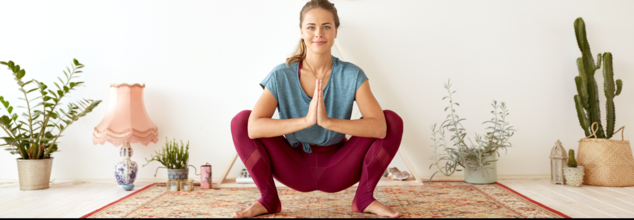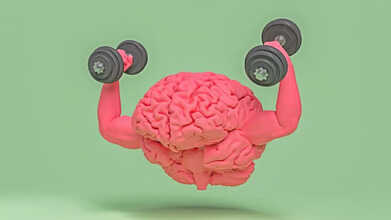- Health Conditions A-Z
- Health & Wellness
- Nutrition
- Fitness
- Health News
- Ayurveda
- Videos
- Medicine A-Z
- Parenting
- Web Stories
Yoga Asanas To Manage Urinary Incontinence And Control Bladder Issues

Yoga for Urinary Incontinence (Credit: Canva)
Millions of women struggle with the discomfort and stress of urinary incontinence, often turning to medications for relief. However, new research suggests that yoga and other exercise regimens might work just as effectively to control bladder issues.
A study conducted by Stanford University revealed that 12 weeks of yoga practice reduced incontinence episodes among participants by an average of 65%—comparable to the effect of medication. Dr. Leslee Subak, senior author of the study and chair of obstetrics and gynecology at Stanford Medicine, encourages women to explore yoga. "It’s very low risk, and there’s potential for benefit not only for incontinence but also for your general well-being," she explained.
The study, published in the Annals of Internal Medicine, involved 240 women aged 45 to 90. Participants engaged in two 90-minute yoga classes per week, learning 16 poses designed to strengthen the pelvic floor muscles, which support the bladder and urethra. The results were promising, with women in the yoga group experiencing a 60% reduction in urinary incontinence episodes.
Impact of Urinary Incontinence
Urinary incontinence affects nearly half of middle-aged women and up to 80% of women aged 80. It can impact independence and cause emotional distress. Dr. Subak notes that many women feel too embarrassed to discuss the issue, which often leads to isolation and anxiety.
Incontinence is not just uncomfortable—it can also be dangerous. The rush to the bathroom at night increases the risk of falls and fractures, especially among older women. This makes finding effective treatments crucial.
The good news is that urinary incontinence is highly treatable. Exercise, especially yoga, offers a non-invasive, natural option for many women.
Yoga Asanas to Control Bladder Issues
Yoga can be an effective tool for improving bladder control because it strengthens the pelvic floor muscles. These muscles play a critical role in keeping the bladder in place and preventing leakage. Unlike general exercise, which doesn’t always target the pelvic floor, yoga focuses on these specific areas. As a result, women who practice yoga often report fewer incontinence episodes.
Some of the yoga poses used to strengthen the pelvic floor include:
1. Bridge Pose (Setu Bandhasana) – This helps strengthen the pelvic floor, thighs, and core.
2. Happy Baby Pose (Ananda Balasana) – A restorative pose that gently stretches the pelvic muscles.
3. Bound Angle Pose (Baddha Konasana) – Targets the groin and inner thighs, which are connected to the pelvic floor.
4. Malasana (Garland Pose): This deep squat position helps stretch the pelvic floor muscles and improve bladder control.
Practising these asanas into a regular yoga routine can help manage bladder control.
Urinary incontinence is most often associated with aging. As women grow older, the muscles that control bladder function may weaken, making it harder to prevent leakage. Pregnant women are also at risk due to increased pressure on the bladder during pregnancy, although the condition usually resolves after delivery.
Medical conditions such as multiple sclerosis, Parkinson’s disease, obesity, and chronic constipation can also contribute to urinary incontinence.
While medications can help, they often come with side effects, especially for older patients. Yoga, on the other hand, is a safe, inexpensive, and accessible option for women looking to manage their urinary incontinence. It not only addresses bladder control but also promotes general well-being, flexibility, and relaxation.
Can Leg Workouts Help Protect Your Brain From Ageing? Expert Weighs In

Credits: Canva
If staying sharp as you grow older is the goal, skipping leg day may not be the best idea. New findings suggest that your brain could benefit just as much as your body from squats and lunges.
A long-term study, first published in Gerontology by Karger Publishers, tracked older female twins for ten years to explore the link between leg strength and cognitive health. The results were clear: participants with stronger legs at the beginning of the study experienced far slower cognitive decline than those with weaker leg muscles.
To understand this connection better, we spoke with Dr. Indramani Upadhyay, MPT (Ortho), HOD – The Center for Knee & Hip Care, Vaishali, Ghaziabad, who shared his insights on the subject.
The Leg–Brain Connection
When we think about keeping the mind sharp, the usual suggestions include solving puzzles, reading, or practicing meditation. Yet growing research shows that one of the strongest ways to support brain health actually starts with the legs. As per Dr Upadhyay, strong leg muscles do more than keep us steady, they play a vital role in protecting memory, learning, and overall cognitive function.
Because the leg muscles are the largest in the body, every time they are put to work they send powerful signals that influence brain chemistry, circulation, and even the growth of new cells. Studies highlight several key benefits:
- Better blood flow: Leg-focused exercises improve circulation, delivering oxygen and nutrients the brain relies on.
- Myokine release: Contracting muscles release proteins known as myokines, which travel through the bloodstream and support nerve health and brain adaptability.
- Neurogenesis boost: Weight-bearing moves like squats and lunges may encourage the growth of new neurons in the hippocampus, the region responsible for memory and learning.
- Stress balance: Physical activity in the legs helps regulate hormones, easing inflammation and reducing stress—two major factors linked to cognitive decline.
Which Leg Exercises Boost Brain Health?
Dr Indramani explains that keeping your legs active does far more than build strength or tone muscles, it also supports brain health. Here are some of the most effective exercises:
1. Strength Training (Squats, Lunges, Step-Ups)
Movements that use your body weight or added resistance work the largest muscle groups in the legs. These exercises not only build muscle and protect bone health, but they also trigger the release of growth factors that sharpen memory and learning.
2. Walking and Jogging
Brisk walking or light jogging are simple yet powerful ways to improve cardiovascular fitness. Better circulation means more oxygen-rich blood reaches the brain. Walking outdoors adds even more value by lowering stress and boosting focus.
3. Cycling
Whether on a road bike or a stationary one, pedaling engages the legs continuously, keeping endurance and blood flow steady. Research links cycling to better reaction times, sharper executive function, and a lower risk of age-related cognitive decline.
ALSO READ: Ebola Outbreak: Why African Countries Are Disproportionately Impacted By The Disease?
4. Yoga Poses (Tree, Chair, Warrior Stances)
Balance-focused yoga postures recruit the legs while also improving flexibility and coordination. This mindful movement helps ease anxiety, sharpen concentration, and strengthen the mind-body connection.
Putting It All Together
The most effective routine is a balanced one: strength training two to three times a week, daily walking or cycling, and yoga for flexibility and balance. Together, they create a foundation that protects both body and brain.
Your legs are more than just a means of movement. They are engines that power your mental resilience. Keeping them strong is an investment not only in mobility but also in memory, focus, and long-term brain health.
Exercising Can Shrink Cancer Cells: Study Reveals Which Sport Protects You the Most

(Credit- Canva)
Cancer affects millions of people worldwide. No matter how careful you are or how healthily you live, cancer may catch you with you sooner or later. Breast cancer is the one of the leading causes of death in women and it was estimated to have caused 670,000 deaths globally and it also the most unpredictable. While there has been research done on it, according to the World Health Organization, half of the breast cancer occurs in women with no specific risk factor other than sex and age.
However, rehabilitation is also very possible, and many people have beaten the odds by surviving breast cancer. When someone goes into cancer remission, they are given some specific treatments so that the cancer does not come back. However, many times it is not as effective.
To find out better ways to keep cancer away, researchers looked into exercising, and focused one fitness program that could prove useful.
The August 2025 study, published in Breast Cancer Research and Treatment journal, suggests that exercising may directly help suppress the growth of breast cancer cells. The research involved 32 women who'd survived breast cancer and found that a single session of high-intensity interval training (HIIT) or weightlifting changed their body's chemistry.
Afterward, their blood contained higher levels of certain molecules that helped put the brakes on laboratory-grown breast cancer cells. This research adds to growing evidence that exercise is a powerful tool for cancer survivors.
How Exercise Works Against Cancer
For years, doctors have known that cancer survivors who exercise are less likely to have their cancer return. This new study helps explain why. When we use our muscles, they release special hormones and biochemicals called myokines into our bloodstream. These myokines are believed to be the body’s natural cancer fighters. In the study, blood taken from the women after they exercised was added to live cancer cells in a lab. The results were clear: the blood from both groups reduced cancer cell growth by 19% to 29%.
What Kind of Exercise is Best For Breast Cancer?
The study compared two types of workouts: HIIT and weightlifting. Both helped, but the blood from the women who did HIIT had a greater effect on the cancer cells, reducing their growth more significantly. This suggests that more strenuous, high-intensity workouts may be more effective at releasing the beneficial myokines, especially a key protein called IL-6. The study found that IL-6 levels were significantly higher in the HIIT group immediately after their workout.
This research has major implications for how we view exercise. It’s no longer just a "nice thing to do" to feel better; it's increasingly being recognized as a powerful tool in cancer treatment. The study's authors believe exercise could be a "first-line treatment" in its own right, alongside traditional therapies like chemotherapy and radiation. If you are a cancer survivor, you should talk to your oncologist before starting a new workout routine, but this study offers a hopeful message that working out can be a simple, accessible, and effective way to improve your health and cut the risk of cancer returning.
Following Japanese Ancient Samurai Routine Could Reduce Risk Of Falls In Seniors

Credits: Canva
Ancient Japanese samurai were known for their discipline, precision, and ritualized approach to life. Now, researchers suggest that their deliberate movements may offer a surprising benefit for modern-day seniors, helping them stay strong, steady, and less prone to falls.
Ancient Samurai Practice Meets Modern Science
A randomized controlled trial from Tohoku University in Japan explored the benefits of Rei-ho, an ancient mindful practice of physical etiquette that involves slow, precise movements like sitting, standing, and walking. The findings were published in the Tohoku Journal of Experimental Medicine. Researchers found that just five minutes of Rei-ho a day can significantly improve knee strength, a crucial factor for mobility and fall prevention in older adults.
"Knee extension strength, the force used to straighten the knees, is a key measure of mobility and daily functioning," explains exercise physiologist Ayaka Ogasawara. "These exciting results suggest that Rei-ho may help seniors maintain their independence."
The Study: Small Effort, Big Gains
Researchers recruited 34 healthy adults over the age of 20, all with no prior experience in Rei-ho. Participants were split into two groups, one group continued their usual daily activities, while the other practiced 20 to 22 Rei-ho squats and sit-to-stand exercises for five minutes a day, four days a week.
After three months, the results were striking. The Rei-ho group showed a 25.9% increase in knee extension strength, compared to just 2.5% in the control group. Such a dramatic improvement in such a short time is encouraging, particularly since stronger knees are linked to better balance and a lower risk of falls.
Although the participants were not seniors, the researchers believe the results could be even more beneficial for older adults, whose lower-limb strength tends to decline more rapidly with age.
Why Lower-Body Strength Matters
As we age, muscle mass and strength naturally decline, a condition known as sarcopenia. This loss is most pronounced in the lower body, which can lead to frailty, poor balance, and an increased risk of falls.
"In recent years, the decline in muscle strength and physical fitness has become a significant public health concern," the researchers write. "The problem is worsened by sedentary lifestyles, making it all the more important to find simple, low-risk interventions that work."
Rei-ho fits the bill perfectly. It uses only body weight, involves slow, controlled motions, and minimizes the risk of injury or spikes in blood pressure that can occur with more intense workouts.
More Than Just Exercise: A Cultural Connection
This is not the first time ancient practices have been found to benefit modern health. Traditional martial arts, yoga, and tai chi have all been linked to improvements in strength, flexibility, and mental focus.
"We think it’s valuable that people outside Japan who want to try Rei-ho would not only improve their health but also experience a unique part of Japanese tradition," says exercise physiologist Akira Sato.
While the study was relatively small and relied on participants to practice without supervision, the findings are promising. For seniors looking for a simple, low-impact way to protect their mobility, Rei-ho offers a unique blend of mindful movement and functional strength training.
In just five minutes a day, following the deliberate movements inspired by samurai tradition might help keep knees strong, reduce fall risk, and allow older adults to stay active and independent for longer.
© 2024 Bennett, Coleman & Company Limited

